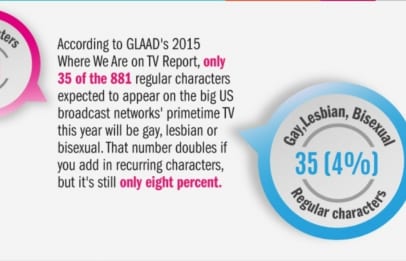
(Since 2005, the LGBT media advocacy organization GLAAD has tracked a significant increase in the number of LGBT characters in TV series. But there’s still work to be done, says CEO Sarah Kate Ellis, in her introduction to GLAAD’s 2015 Network Responsibility Index. “Putting LGBT people onscreen isn’t enough; there must be thought, care, and substance behind it.”/Daily Xtra)
A couple of weeks ago I couldn’t stop telling anyone who would listen about the most amazing film I had just seen. The Way He Looks, a 2014 Brazilian coming-of-age romantic drama, was extraordinary to me because:
a) It had realistic and complex queer main characters
b) It was well written, acted, and filmed
c) It was not depressing and no one died
This seems like it should be a low bar to reach. But unless there’s some hidden section on Netflix that no one’s told me about — “suggestions for you based on your interests in LGBT Film and Not Crying Right Now” — then finding media that meets this criteria is noteworthy.
Vancouver poets Daniel Zomparelli and Dina Del Bucchia explore some of these themes of representation in their new book of poetry Rom Com.
As a less than poetic person myself, I found the book engaging and surprisingly accessible. The poems range from a series written about Jennifers (Aniston, Lopez, Lawrence) to quizzes that measure “If You Might Be the Best Friend of a Romantic Lead” (one criteria: “you tell everyone you are married to one-liners.”)
Rom Com also delves into more complex matter. A pair of poems to Adam Sandler contrast feelings of having a crush on his charming, silly, immature persona to feelings of being crushed by the homophobia, transphobia, and racism of his films, not to mention the audience laugher at those “jokes.” (“The movie came at me with fists, it closed around my neck.”)
I asked Zomparelli what movie he would recommend to someone who had never seen a rom com before. Funny thing is, I couldn’t stand his suggestion.
Though he’s quick to acknowledge that a favourite rom com can be shaped as much by the moment we first watch it (just-post-break-up?) as the quality of the film, his go-to left me cold. (It’s called Forgetting Sarah Marshall and, for Zomparelli, it’s about reconnecting to self and art as the lead character moves through a break-up. For me, had the movie been a sandwich, the mayonnaise of misogyny would have completely overpowered any chance of me tasting the plot.)
Like so many other mainstream rom coms, Forgetting Sarah Marshall also has another fatal flaw: no queer characters.
I’d like to exist. And not just in a throw-away character, either. Representation isn’t just about the characters existing, but also the quality of the characters and how they’re treated.
Queer and trans people, people of colour, even women, do not yet consistently receive this kind of quality representation in media. While casts have begun to move away from being composed of exclusively straight white men, “diverse” characters are still often singular, one-dimensional, and stereotypical. We deserve better than the sassy desexualized sidekick, the exoticized other, or the one-dimensional love interest.
Overcoming this is certainly not impossible. The recent series Sense8 was extraordinary because its cast was so diverse that no one character was the “diverse” character, and each character’s personality was more than just the marginalized parts of their identities.
I look forward to this becoming the norm in media.
Until then, if your relationship with mainstream rom coms remains, like mine, love/hate, on-again/off-again, or just “it’s complicated,” then Rom Com might be a great place to share a laugh and maybe some tears of disappointment in mainstream media representation.
I not only felt represented in these poems, but also seen and validated. Plus, with many of the poems’ gender-ambiguity, I could easily see my own romantic life woven through their imagery.
Rom Com doesn’t shy away from being critical of mainstream romantic comedies, even as it unabashedly expresses its love for the genre.
(Rom Com
Dina Del Bucchia and Daniel Zomparelli

 Why you can trust Xtra
Why you can trust Xtra


